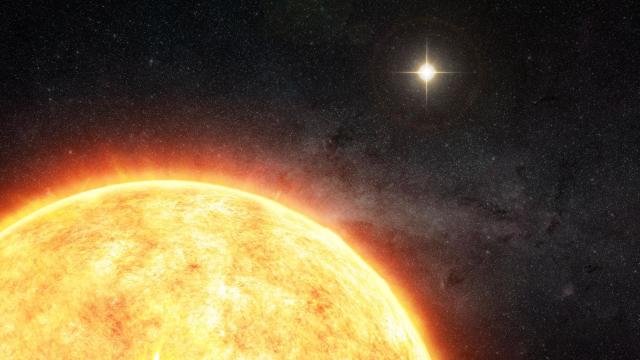The strange configuration of material in the outer reaches of our solar system has led a team of scientists to speculate that the Sun had a companion during its early days. Intriguingly, this scenario could explain the presence of the hypothesised Planet Nine, should it actually exist.
Our Sun’s hypothetical twin is long gone, but traces of it can be seen in the overabundance of material located within the outer Oort Cloud, according to new research published in The Astrophysical Journal Letters.
The Oort cloud is the most distant region in the solar system, residing much farther than the outer planets and the Kuiper Belt. Unlike the Kuiper Belt, which is shaped like a doughnut, the Oort cloud is a massive and thick spherical shell that envelopes the entire solar system. The inner Oort cloud starts at around 1,000 AU from the Sun (in which 1 AU is the average distance from Earth to the Sun), while its outer edge stops at around 100,000 AU.
This region of space is filled with billions, possibly trillions, of rocky and icy objects left over from the formation of the solar system. According to the new paper, the overabundance of material presumed to exist in the outer Oort cloud is the result of our Sun’s early stint as a binary system.
To date, computers trying to simulate the formation of the solar system have failed to reproduce the proportion of objects seen in the outer realms of the Oort cloud and the scattered disc — a specific population of trans-Neptunian objects outside of the Kuiper Belt. As a result, the origin of the outer Oort cloud is “an unsolved mystery,” according to the paper, authored by astronomers Avi Loeb and Amir Siraj from the Centre for Astrophysics at Harvard & Smithsonian.
The new paper presents an elegant solution to the overpopulation problem: a second sun.
“A stellar companion to the Sun would increase the chance of trapping objects from the birth cluster of the Sun,” wrote Loeb in an email. “The Sun and its companion act as a fishing net that traps objects gravitationally as they pass near one of the two stars and lose energy by kicking it slightly.”
By birth cluster, Loeb is referring to a cluster of stars that arose together in the same molecular cloud, also known as a stellar nursery. Star clusters eventually scatter, either because of strong stellar winds or tidal gravitational forces exerted by the Milky Way galaxy itself. The Sun’s hypothesised twin would have been pulled far, far away.
“The popular theory associates the origin of the Oort cloud with debris left over from the formation of the solar system,” said Loeb. “Objects were scattered by the planets to great distances. But this model has difficulty reproducing the observed ratio between the scattered disk population of objects and the more spherical Oort cloud. Our model can account for that ratio.”
The hypothesised second sun, in order to trap this excess material, would require a mass comparable to our own Sun. So, basically a twin. The two stars would would have been roughly 1,000 AU apart, according to the new model.
“It is entirely plausible that the Sun could have started its life as a binary system,” Konstantin Batygin, a professor of planetary science at the California Institute of Technology who wasn’t involved in the new study, said in an email. “In fact, observations of young star clusters suggest that a very large fraction of sun-like stars are born as multiples, which later dissociate.”
Copious amounts of celestial material would have been lost when the two stars separated, but the authors contend that enough material remained to explain the Oort cloud. Passing stars in the birth cluster were likely responsible for separating the Sun from its presumed companion, but not before our solar system captured its outer population of objects, namely the Oort cloud and — quite possibly — the elusive Planet Nine. This gigantic hypothetical planet, described by Batygin and his Caltech colleague Mike Brown in 2016, is thought to exist in the outer solar system owing to the peculiar clustering of certain Kuiper Belt objects.
A going origin story for Planet Nine is that it formed as a gas giant in the inner solar system, but it got shoved into the outer solar system after straying too close to Jupiter. The new paper offers an alternative scenario: Planet Nine was captured by our solar system.
“The formation puzzle does not only involve the Oort clouds but also the extreme trans-Neptunian objects, like the potential Planet Nine,” said Loeb. “It is unclear where they came from, and our model predicts that there should be more objects with a similar orbital orientation as Planet Nine.”
Indeed, Planet Nine could be a literal ninth planet or an entire population of dwarf planets, or even a massive ring of debris.
“Siraj and Loeb put forward a novel idea for the early history of our solar system and give an interesting new take on the possible origins of the hypothetical Planet Nine,” James Unwin, a physicist at the University of Illinois at Chicago who’s not affiliated with the new research, said in an email. “It’s notable that the authors present a testable hypothesis in the form of an overabundance of dwarf planets, and it will certainly be interesting to see if this is confirmed in future observations.”
The upcoming Vera C. Rubin Observatory, which is scheduled to open in 2021, has the potential to prove or disprove the existence of Planet Nine. As for finding our Sun’s long-lost twin, that could be intractably difficult. As Siraj noted in a Harvard & Smithsonian press release, this forlorn star “could now be anywhere in the Milky Way.”
Shame. But seriously, how cool would it be to actually find our Sun’s closest sibling?
